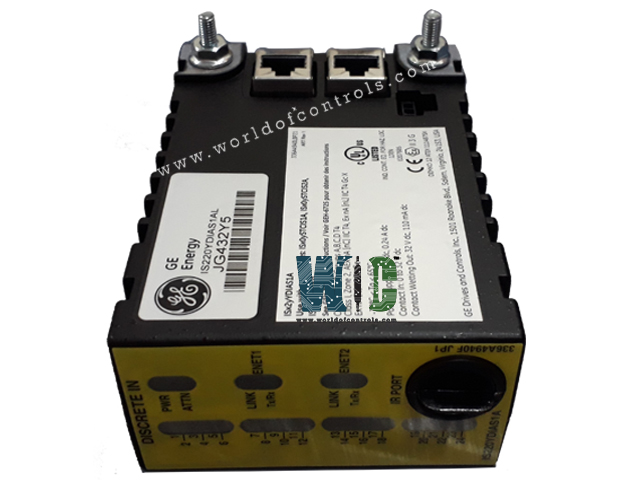
World Of Controls understands the criticality of your requirement and works towards reducing the lead time as much as possible.
IS220YDIAS1B - Simplex Contact I/O Terminal Board is available in stock which ships the same day.
IS220YDIAS1B - Simplex Contact I/O Terminal Board comes in UNUSED as well as REBUILT condition.
To avail our best deals for IS220YDIAS1B - Simplex Contact I/O Terminal Board, contact us and we will get back to you within 24 hours.
SPECIFICATIONS:
Part Number: IS220YDIAS1B
Manufacturer: General Electric
Series: Mark VIe
Product Type: Simplex Contact I/O Terminal Board
Wetting Voltage Options: 24 V DC
Network Interface: Dual RJ-45
Technology: Surface Mount
Signal Connector: DC-37
Supported Software: ControlST
Common Mode Voltage Range: ±5 V
Dimensions: 11.00 x 9.00 x 3.00
Operating temperature: 0 to 60 °C
No.of Analog Voltage Inputs: 6
Repair: 3-7 days
Availability: In Stock
Country of Origin: United States
FUNCTIONAL DESCRIPTION:
IS220YDIAS1B is a Simplex Contact I/O Terminal Board manufactured and designed by General Electric as part of the VIe Series used in GE Distributed Control Systems. The Discrete Input (YDIA) I/O pack provides the electrical interface between one or two I/O Ethernet networks and a discrete input terminal board. The YDIA contains a BPPx processor board and an acquisition board specific to the discrete input function. The I/O pack accepts up to 24 contact inputs and terminal board-specific feedback signals. Three different wetting voltages are available, and isolated discrete input voltage sensing is also available when using a supported terminal board.
System input to the I/O pack is through dual RJ-45 Ethernet connectors and a three-pin power input. Discrete signal input is through a DC-37 pin connector that connects directly with the associated terminal board connector. Visual diagnostics are provided through indicator LEDs. Contact input terminal board types provide the following options:
PDIA I/O PACK – PROCESSOR BOARD COMPATIBILITY:
The PDIA (Discrete Input) I/O Pack serves as a vital interface module in turbine control systems and industrial automation setups, offering seamless communication between discrete input signals and the system’s Ethernet-based I/O networks. Each PDIA I/O pack includes one of the following BPPx-series processor boards, which are responsible for managing the logic, signal acquisition, and network interfacing of the I/O pack.
REDUNDANCY OPTIONS FOR HIGH AVAILABILITY:
To meet varying reliability and fault-tolerance needs in critical systems, the PDIA I/O pack supports multiple redundancy configurations. These options are essential in high-integrity systems such as gas and steam turbines, where continuous operation and fail-safe performance are crucial.
SIMPLEX CONFIGURATION:
DUAL REDUNDANCY CONFIGURATION:
TRIPLE MODULAR REDUNDANCY (TMR) CONFIGURATION:
WOC has the largest stock of Replacement parts for GE Distributed Turbine Control Systems. We can also repair your faulty boards and supply unused and rebuilt boards backed up with a warranty. Our team of experts is available around the clock to support your OEM needs. Our team of experts at WOC is happy to assist you with any of your automation requirements. For pricing and availability on parts and repairs, kindly contact our team by phone or email.
What wetting voltages are supported by YDIA?
YDIA supports 24 VDC, 48 VDC, and 125 VDC wetting voltages, depending on the terminal board used (e.g., YDTA).
What is the default number of input channels?
The YDIA supports 24 discrete input channels by default. These channels are optically isolated and are used to detect contact closures or open states from field equipment connected through its terminal board, typically a YDTA.
What type of input signals does YDIA accept?
YDIA accepts dry-contact digital inputs, which means the signals are simply contact closures or openings without supplying external voltage. The pack senses whether the contact is closed (signal ON) or open (signal OFF) using the wetting voltage supplied from the terminal board.
What wetting voltages are supported by YDIA?
YDIA supports a range of wetting voltages, including 24 VDC, 48 VDC, and 125 VDC. These voltages are provided through the terminal board (such as YDTA) and are used to detect contact closures from field devices. The choice of wetting voltage depends on the field application and system design.